Vegetarian Keto Meal Plan for Beginners: A Tasty Way to Lose Weight and Feel Great
Struggling to Start a Vegetarian Keto Diet?
Starting a new diet can be tough, especially when you’re trying to combine two specific lifestyles, vegetarianism and keto. If you’re new to both, it might feel like there are no options left! But guess what? A vegetarian keto meal plan for beginners is not only possible but also incredibly satisfying and healthy. Whether you’re cutting out meat for ethical reasons or just looking to try something new, this guide will walk you through everything you need to know to start your journey with confidence.
Also read – Easy Keto Meal Plan for Beginners
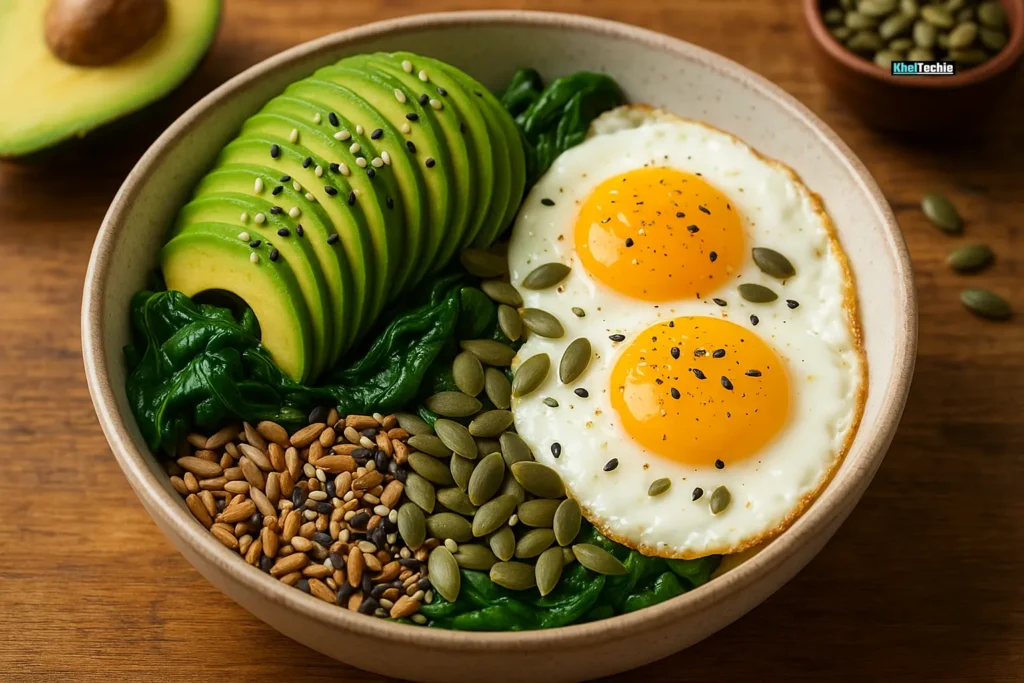
What is a Vegetarian Keto Meal Plan?
A vegetarian keto diet combines the principles of vegetarianism with the ketogenic diet. It emphasizes high-fat, moderate-protein, and low-carbohydrate intake, all while excluding meat and fish. The goal is to enter a state of ketosis, where your body burns fat for energy instead of carbohydrates.
Core Components:
- High-Fat Foods: Avocados, nuts, seeds, coconut oil, olive oil.
- Moderate-Protein Sources: Eggs, dairy products, tofu, tempeh.
- Low-Carb Vegetables: Leafy greens, zucchini, cauliflower, broccoli.
Foods to Limit or Avoid:
- Sugary Foods: Sweets, sugary beverages, most fruits.
- High-Carb Vegetables: Potatoes, corn, peas.
- Grains and Legumes: Rice, wheat, lentils, beans.
Think of it as a puzzle, you’re choosing foods that fit both the keto and vegetarian rules. It’s like building a house with two blueprints, but once you get the hang of it, it becomes second nature.
Why This Meal Plan Matters
If you’re wondering why someone would choose a vegetarian keto meal plan, here are a few key reasons:
- Weight Loss: Studies show that the keto diet can help people lose weight quickly by reducing insulin levels and increasing fat burning .
- Improved Blood Sugar Control: Some research suggests ketogenic diets may reduce lipogenesis, the process of converting sugar into fat. This is because excess carbs are stored as fat. When there’s a minimal intake of carbs, fat is used for energy.
- Ethical and Environmental Reasons: Many people avoid meat due to concerns about animal welfare or sustainability. A vegetarian keto diet allows them to stay true to their values while still reaping the benefits of keto.
- Heart Health: Eating more plant-based fats like avocados, nuts, and olive oil can improve cholesterol levels and reduce heart disease risk.
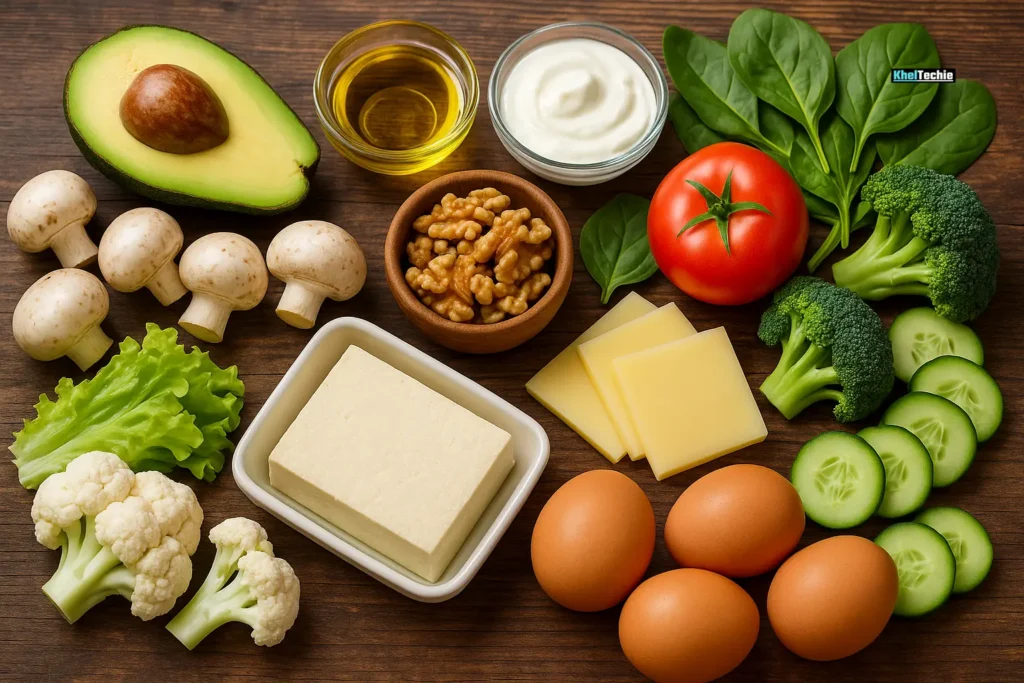
Step-by-Step Guide to Building Your Vegetarian Keto Meal Plan
Creating a vegetarian keto meal plan doesn’t have to be complicated. Let’s break it down into easy steps so you can build a delicious, balanced, and nutritious plan tailored to your needs.
Step 1: Understand What You Can Eat
The foundation of any successful keto plan is knowing which foods are allowed. Here’s a quick list of vegetarian-friendly keto staples:
| Food Group | Examples |
|---|---|
| Healthy Fats | Avocado, olive oil, coconut oil, butter, ghee |
| Protein Sources | Eggs, Greek yogurt, cottage cheese, tofu, tempeh |
| Low-Carb Veggies | Spinach, kale, zucchini, cauliflower, broccoli |
| Nuts & Seeds | Almonds, walnuts, chia seeds, flaxseeds, pumpkin seeds |
| Dairy (if tolerated) | Cheese (cheddar, mozzarella), heavy cream, sour cream |
| Beverages | Water, herbal tea, black coffee, unsweetened almond milk |
Avoid high-carb foods like bread, pasta, rice, sugar, and most fruits (except small amounts of berries).
Step 2: Calculate Your Macros
Keto works best when you track your macronutrients, fat, protein, and carbs. Most people aim for:
- 70–75% Fat
- 20–25% Protein
- 5–10% Carbs
You can use online calculators like to determine your daily targets based on age, weight, height, and activity level.
Step 3: Plan Your Meals Around the Day
Let’s look at a sample day using real food ideas:
Breakfast Ideas
- Avocado Egg Bowl: Mashed avocado topped with poached eggs, spinach, and a sprinkle of hemp seeds.
- Greek Yogurt Parfait: Full-fat Greek yogurt with crushed almonds, chia seeds, and a few raspberries.
- Chia Pudding: Made with unsweetened almond milk, chia seeds, and a dash of cinnamon.
Lunch Ideas
- Cauliflower Rice Stir Fry: Sautéed cauliflower rice with tofu, tamari, sesame oil, and veggies like bell peppers and snap peas.
- Zucchini Noodles with Pesto: Spiralized zucchini tossed in homemade basil pesto with pine nuts and Parmesan.
- Keto Veggie Wrap: Collard green wrap filled with hummus, shredded cucumber, bell pepper, and sunflower seeds.
Dinner Ideas
- Stuffed Bell Peppers: Roasted red peppers filled with quinoa, black beans, cheese, and spices.
- Coconut Curry with Tempeh: Creamy curry made with full-fat coconut milk, tempeh, and low-carb veggies like eggplant and cauliflower.
- Spinach and Feta Omelette: Fluffy omelette packed with fresh spinach and crumbled feta.
Snack Ideas
- Hard-boiled eggs
- Celery sticks with almond butter
- Handful of mixed nuts
- Olives or pickles
- Cottage cheese with flaxseeds
Step 4: Prep Like a Pro
Meal prep is your secret weapon for success. Spend a couple of hours each week prepping ingredients like roasted veggies, hard-boiled eggs, and batch-cooked tofu or tempeh.
Use mason jars or reusable containers to store meals in the fridge. Label them with days of the week for easy grab-and-go access.
Step 5: Stay Hydrated and Supplement Smartly
When you cut carbs, your body excretes more water and electrolytes. Be sure to drink plenty of water and consider supplementing with:
- Sodium: Add Himalayan salt to meals or drink broth.
- Potassium: Found in leafy greens, avocados, and mushrooms.
- Magnesium: Found in nuts, seeds, and dark chocolate.
Some people take an electrolyte supplement to stay balanced.
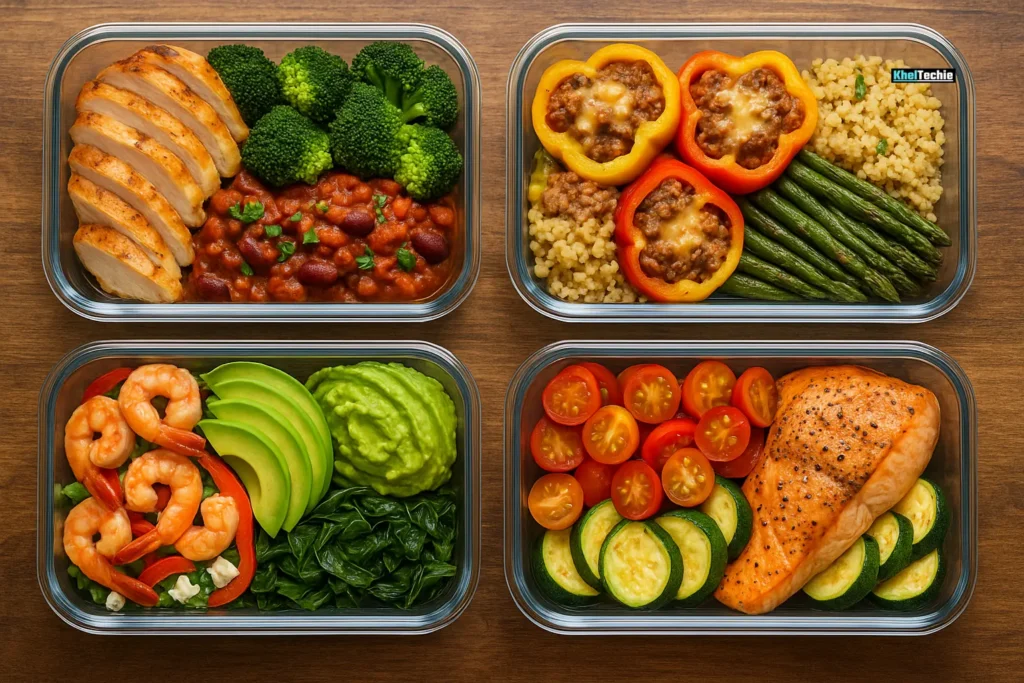
7-day Vegetarian Keto Meal Plan for Beginners
Here’s a 7-day meal plan to kickstart your vegetarian keto journey. Each day includes breakfast, lunch, dinner, and a snack.
Day 1:
- Breakfast: Scrambled eggs with spinach and feta cheese cooked in olive oil.
- Lunch: Zucchini noodles with pesto and grilled tofu.
- Dinner: Cauliflower rice stir-fry with assorted low-carb vegetables and tempeh.
- Snack: Handful of almonds.
Day 2:
- Breakfast: Greek yogurt with chia seeds and a few raspberries.
- Lunch: Stuffed bell peppers with cauliflower rice and cheese.
- Dinner: Eggplant lasagna with ricotta and mozzarella.
- Snack: Celery sticks with almond butter.
Day 3:
- Breakfast: Avocado smoothie with unsweetened almond milk and protein powder.
- Lunch: Kale salad with boiled eggs, avocado, and olive oil dressing.
- Dinner: Mushroom and cheese omelet with a side of sautéed greens.
- Snack: Cheese slices with cucumber.
Day 4:
- Breakfast: Coconut flour pancakes with sugar-free syrup.
- Lunch: Broccoli and cheddar soup.
- Dinner: Zucchini boats filled with ricotta and spinach.
- Snack: Olives and a few walnuts.
Day 5:
- Breakfast: Chia pudding made with coconut milk and topped with a few blackberries.
- Lunch: Grilled portobello mushrooms with goat cheese.
- Dinner: Spaghetti squash with marinara sauce and parmesan.
- Snack: Hard-boiled egg.
Day 6:
- Breakfast: Tofu scramble with bell peppers and onions.
- Lunch: Cauliflower crust pizza with mozzarella and basil.
- Dinner: Stuffed zucchini with mushrooms and cheese.
- Snack: Macadamia nuts.
Day 7:
- Breakfast: Almond flour muffins with butter.
- Lunch: Egg salad lettuce wraps.
- Dinner: Creamy spinach and mushroom casserole.
- Snack: Cucumber slices with cream cheese.
This meal plan ensures a balance of fats, proteins, and low-carb vegetables to keep you in ketosis while adhering to vegetarian principles.
Common Mistakes to Avoid
Even the best-laid plans can go wrong if you overlook these common pitfalls:
❌ Not Getting Enough Fat
Many beginners under-eat fat thinking they’ll lose weight faster. But without enough fat, you’ll feel hungry and sluggish. Make sure every meal includes a healthy source of fat.
❌ Overeating Protein
Too much protein can kick you out of ketosis because your body converts excess protein into glucose via gluconeogenesis. Stick to moderate portions, about 0.6–0.8 grams per pound of lean body mass.
❌ Ignoring Fiber
Fiber is essential for gut health, even on keto. Include non-starchy veggies and low-carb seeds like chia, flax, and psyllium husk.
❌ Eating Hidden Carbs
Check labels carefully! Some low-carb products are loaded with hidden sugars or starches. Always read the nutrition facts and net carb count.
❌ Giving Up Too Soon
The first few days can be rough, headaches, fatigue, and cravings are common during the keto flu. Hang in there! These symptoms usually pass within a week.
Also read – Best Plant-Based Protein Sources
Final Thoughts: Start Simple, Stay Consistent
A vegetarian keto meal plan for beginners might seem tricky at first, but with the right tools and mindset, it can become a delicious and sustainable lifestyle. Focus on whole, unprocessed foods, stay hydrated, and don’t forget to enjoy your meals!
If you found this guide helpful, feel free to share it with friends or leave a comment below with your favorite keto recipe or tip. Happy cooking, and happy keto-ing!
Frequently Asked Questions
Can I really do keto without meat?
Yes! While meat is a common source of protein on keto, vegetarians can rely on eggs, dairy, tofu, and other plant-based proteins. Just be mindful of carb counts and balance your macros properly.
Are there any good vegetarian keto snacks?
Absolutely! Try:
Sugar-free jerky (made from mushrooms or tofu)
Cheese cubes
Deviled eggs
Roasted seaweed
Macadamia nuts
What can I eat on a vegetarian keto diet?
Stick to foods like:
Plant-based proteins (tofu, tempeh)
Eggs
High-fat dairy (cheese, Greek yogurt)
Low-carb veggies (spinach, zucchini, cauliflower)
Healthy fats (avocado, olive oil, nuts)
Will I get enough protein?
Yes, but you’ll need to plan carefully. Aim for 20–25% of your calories from protein-rich foods like eggs, cottage cheese, and tofu.
Can I eat fruit on a vegetarian keto diet?
Most fruits are high in carbs, but you can enjoy small amounts of berries (strawberries, raspberries) in moderation.
How do I track my carbs?
Use apps like MyFitnessPal or Cronometer to log your food and monitor net carbs. Aim for under 20–30g per day
Is a vegetarian keto diet safe long-term?
While more research is needed, short-term studies suggest that well-planned keto diets are safe for most people. Always consult a healthcare provider before starting any new diet, especially if you have underlying conditions
Can I eat out on a vegetarian keto diet?
Yes, but be cautious. Look for dishes with:
Grilled veggies
Salads with oil-based dressings
Cheese or egg-based appetizers
Ask for substitutions like cauliflower rice instead of regular rice.
How do I deal with cravings?
Cravings often fade after the first week. In the meantime, try: Drinking more water Eating more fat Having a keto-friendly treat like dark chocolate (85%+ cocoa) Chewing gum sweetened with erythritol
Do I need to take supplements?
It’s wise to supplement with electrolytes, especially in the beginning. Consider adding vitamin B12, omega-3s, and a multivitamin if you’re not eating a wide variety of foods.
Image Suggestions (Alt Text Included)
- Image 1: “Vegetarian keto breakfast bowl with avocado, eggs, and seeds”
- Image 2: “Low-carb grocery shopping list with keto-friendly items”
- Image 3: “Meal prep containers with colorful keto meals”
- Image 4: “Electrolyte supplements for keto beginners”
Let me know if you’d like the article exported in a different format or optimized further for SEO or voice search!

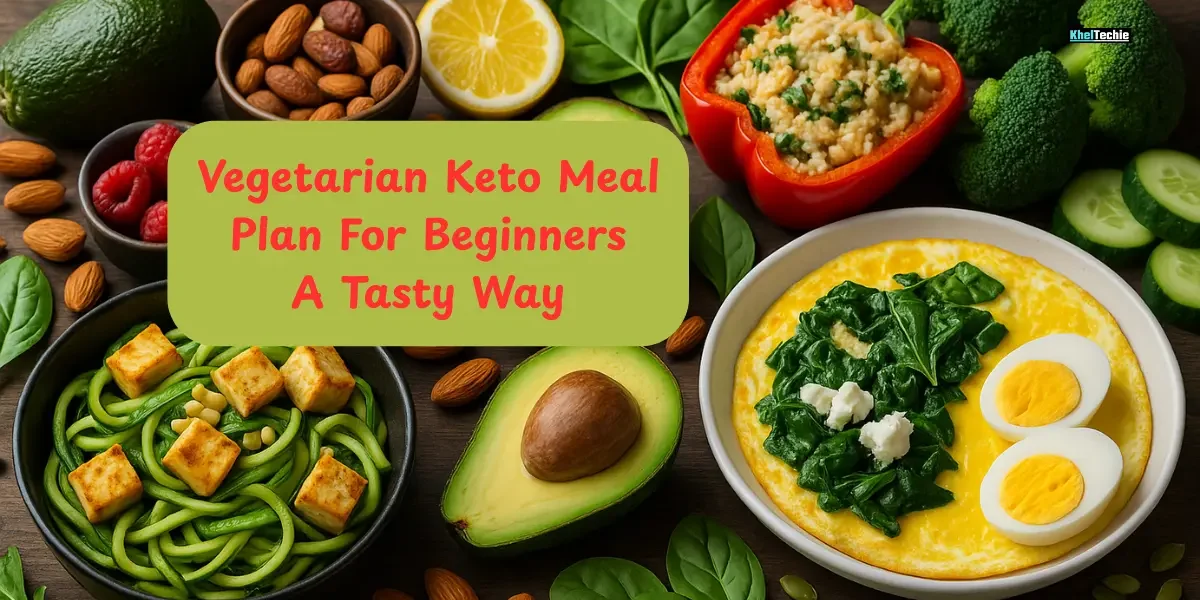

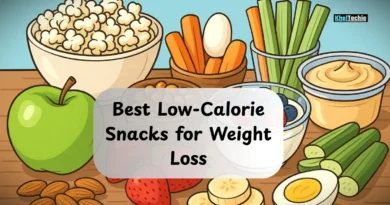

Pingback: 30-Day Keto Challenge Meal Plan: Your Fat-Fueled Success
Pingback: Best Vegan Protein Sources For Athletes: Build Muscle Now